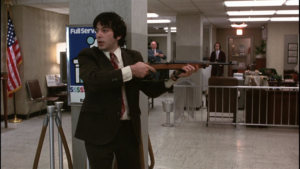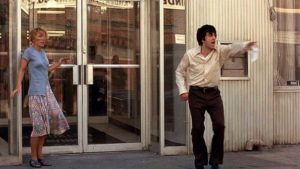Sidney Lumit’s Dog Day Afternoon (1975), based on a true story, opens with several wholesome shots of urban America à la A Tree Grows in Brooklyn (1945), but fifty years later. After seeing a boy play baseball, a dog rifle through trash, and a boat pull up to a loading dock, you might think you’re in for an indie drama, not a true crime film. But for a true crime film, Dog Day Afternoon is as introspective as it gets.
Indie films, like literary novels as opposed to commercial novels, slow down to examine the complexity of life. The plotline in which those complexities play out takes a secondary role. Heist movies, on the other hand, (think Ocean’s 11) prioritize action and excitement over contemplating the reasons a given character might try to, for instance, steal a fortune. Enter: Al Pacino.
An Introspective True Crime Drama
In Dog Day Afternoon, Pacino gives an impassioned performance, vaulting into the manic headspace of Sonny Wortzik, a marked difference from the stoic Michael Corleone of The Godfather (1972). From the first few shots of Dog Day, Lumit makes it clear this movie will examine character and place as much as the plot. That also holds true in the first few moments of the bank robbery. Sonny’s team is comically disorganized, contrasting the militarized gangs of many action movies today, such as the bank robbers in The Dark Knight Rises (2012).
The first disaster of Dog Day Afternoon comes when the third member of Sonny’s trio bails just before Sonny unveils his weapon in the bank. After heading out, the deserter darts back into the bank, as Sonny unleashes his weapon from its cardboard sheath, and hands Sonny the keys to the getaway car. This exchange acts as a thesis statement for the film. You wouldn’t normally expect a bank robber to pause a hold-up to grab the car keys from his would-be accomplice. But in Pacino’s frantic portrayal of Sonny, this exchange seems characteristic of the group of friends. Oh, I mean bank robbers.

The movie doesn’t glorify Sonny, although his narcissism and star power mesmerize the onlookers who come to watch the police stand-off. He’s just a normal guy, robbing a bank! What’s not to like? The humanization of the movie’s public enemy protagonists works uniquely well in this true-crime drama. Most crime movies maximize villainy for the sake of the plot. Dog Day Afternoon does the opposite, using the mutual humanity of both sides to create tension.
Diversity and Social Commentary
About halfway through the movie, Sonny reveals he conducted the heist in order to steal money to pay for his extra-marital partner’s sex-change operation. During the climactic scene, when Sonny calls his partner Bobby, Bobby reminds Sonny he never asked him to rob a bank for him. Sonny says he knows this, and his eyes sink in disappointment and self-loathing. Later, Sonny lists Bobby as the primary beneficiary in his will, but screams at his wife on the phone. How could you do this? she keeps asking. He has no answer.
The movie’s social commentary is potent and, viewed in 2021, surprising. While Sonny holds up the bank, onlookers outside hold signs that say We Love You, Sonny! The film investigates territory that many crime dramas avoid: the motivations of criminals. Often, crime dramas portray criminals as incorrigible and damningly selfish, with no motivation other than thoughtless, incomprehensible greed. The lesson in these movies is always the same: don’t mess with the law. In Fargo (1999), Frances McDormand scornfully says to the serial killer in the back seat of her cop car, “And all for a little bit of money.” And that’s that.

But Dog Day Afternoon does not demarcate so clearly between good and evil. It doesn’t characterize the police as righteous arbiters of justice, but rather, begrudging and, at times, impulsive enforcers of the law. While Sonny holds hostages in a bank, he orders them pizza and gives them bathroom breaks. Additionally, he robbed the bank to pay for his partner’s sex-change operation. If health insurance companies had been more inclusive in their coverage, this could have been avoided. Progressive for 1975, right?
Where It Falls Short
For all its progressiveness, like many films today, Dog Day Afternoon‘s social conviction plays out in a bubble of whiteness. At the beginning of the movie, Sonny lets the first hostage, a bank security guard, go. The police waiting outside seize on him. “He’s a hostage,” one of the tellers yells frantically. The audience seizes with suspense as we realize the police believe the black man exiting the bank to be the robber. But when the security guard reaches safety, the movie moves on, no longer concerned with race. However, Dog Day‘s central argument, that societal disenfranchisement leads to crime, is, in practicality, inextricably tied to race.
The movie’s racial commentary takes place on the periphery of the film. It’s a reminder to the white people watching that the white America the movie romanticizes isn’t perfect. If a black man had robbed the bank, the movie would have been very different tonally. In America, black crime is often seen as incorrigible or disdainful. White crime, however, elicits sympathy. Sonny elicits this sympathy despite his status as a sexual minority because of his whiteness. That being said, there are still most likely plenty of people who watched Dog Day Afternoon and said, Throw that him in jail! in the most bigoted way possible. And that’s where John Wojtowicz- the real-life Sonny- wound up in real life: behind bars for twenty years. What can you do?

Comments